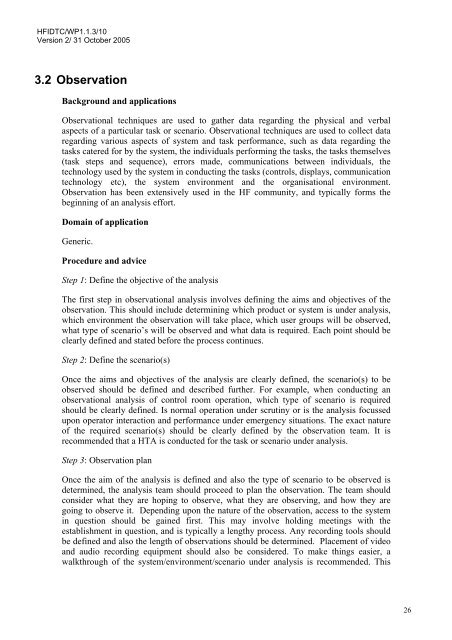A Review of the Event Analysis of Systemic Teamwork Methodology
A Review of the Event Analysis of Systemic Teamwork Methodology
A Review of the Event Analysis of Systemic Teamwork Methodology
- No tags were found...
Create successful ePaper yourself
Turn your PDF publications into a flip-book with our unique Google optimized e-Paper software.
HFIDTC/WP1.1.3/10<br />
Version 2/ 31 October 2005<br />
3.2 Observation<br />
Background and applications<br />
Observational techniques are used to ga<strong>the</strong>r data regarding <strong>the</strong> physical and verbal<br />
aspects <strong>of</strong> a particular task or scenario. Observational techniques are used to collect data<br />
regarding various aspects <strong>of</strong> system and task performance, such as data regarding <strong>the</strong><br />
tasks catered for by <strong>the</strong> system, <strong>the</strong> individuals performing <strong>the</strong> tasks, <strong>the</strong> tasks <strong>the</strong>mselves<br />
(task steps and sequence), errors made, communications between individuals, <strong>the</strong><br />
technology used by <strong>the</strong> system in conducting <strong>the</strong> tasks (controls, displays, communication<br />
technology etc), <strong>the</strong> system environment and <strong>the</strong> organisational environment.<br />
Observation has been extensively used in <strong>the</strong> HF community, and typically forms <strong>the</strong><br />
beginning <strong>of</strong> an analysis effort.<br />
Domain <strong>of</strong> application<br />
Generic.<br />
Procedure and advice<br />
Step 1: Define <strong>the</strong> objective <strong>of</strong> <strong>the</strong> analysis<br />
The first step in observational analysis involves defining <strong>the</strong> aims and objectives <strong>of</strong> <strong>the</strong><br />
observation. This should include determining which product or system is under analysis,<br />
which environment <strong>the</strong> observation will take place, which user groups will be observed,<br />
what type <strong>of</strong> scenario’s will be observed and what data is required. Each point should be<br />
clearly defined and stated before <strong>the</strong> process continues.<br />
Step 2: Define <strong>the</strong> scenario(s)<br />
Once <strong>the</strong> aims and objectives <strong>of</strong> <strong>the</strong> analysis are clearly defined, <strong>the</strong> scenario(s) to be<br />
observed should be defined and described fur<strong>the</strong>r. For example, when conducting an<br />
observational analysis <strong>of</strong> control room operation, which type <strong>of</strong> scenario is required<br />
should be clearly defined. Is normal operation under scrutiny or is <strong>the</strong> analysis focussed<br />
upon operator interaction and performance under emergency situations. The exact nature<br />
<strong>of</strong> <strong>the</strong> required scenario(s) should be clearly defined by <strong>the</strong> observation team. It is<br />
recommended that a HTA is conducted for <strong>the</strong> task or scenario under analysis.<br />
Step 3: Observation plan<br />
Once <strong>the</strong> aim <strong>of</strong> <strong>the</strong> analysis is defined and also <strong>the</strong> type <strong>of</strong> scenario to be observed is<br />
determined, <strong>the</strong> analysis team should proceed to plan <strong>the</strong> observation. The team should<br />
consider what <strong>the</strong>y are hoping to observe, what <strong>the</strong>y are observing, and how <strong>the</strong>y are<br />
going to observe it. Depending upon <strong>the</strong> nature <strong>of</strong> <strong>the</strong> observation, access to <strong>the</strong> system<br />
in question should be gained first. This may involve holding meetings with <strong>the</strong><br />
establishment in question, and is typically a lengthy process. Any recording tools should<br />
be defined and also <strong>the</strong> length <strong>of</strong> observations should be determined. Placement <strong>of</strong> video<br />
and audio recording equipment should also be considered. To make things easier, a<br />
walkthrough <strong>of</strong> <strong>the</strong> system/environment/scenario under analysis is recommended. This<br />
26
















